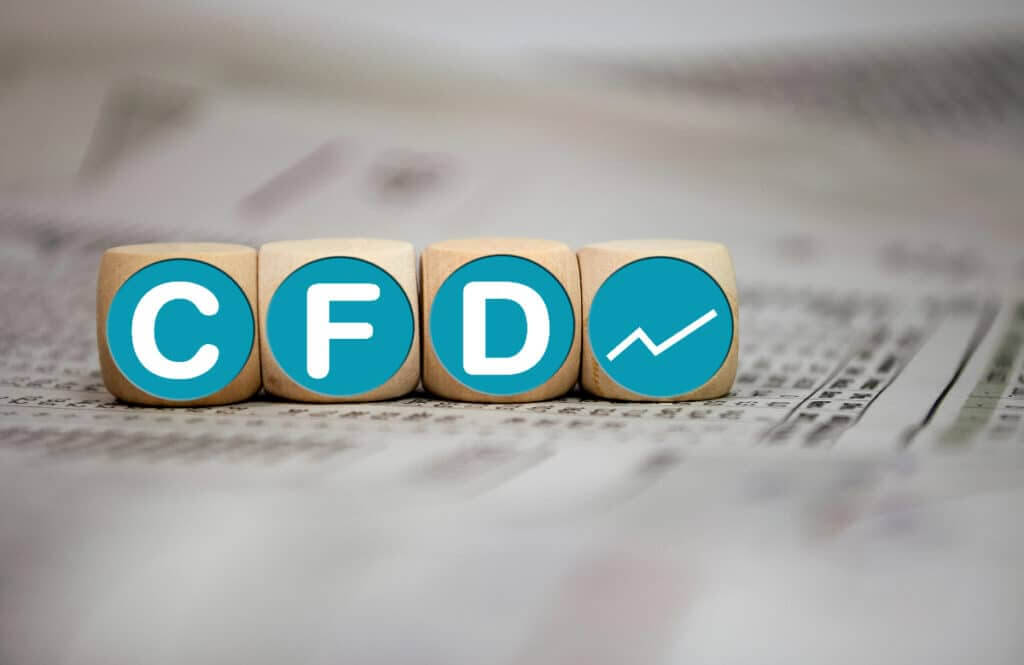
What Are CFDs and How Do They Work: Get All The Information
CFD – A difference agreement in compliance between a buyer and a seller that imposes that the buyer must pay the seller the contrast between the asset’s present amount and its value at the time of the contract.
CFDs allow traders to take advantage of price action without owning fixed assets. The cost of the CFD contract does not include the underlying cost of the purchase. Only the price changes between trade entry and exit.
This is manageable through the broker and the client; It does not use any commodities, stock, forex, or futures. Trading CFDs has several significant advantages that have boosted the popularity of the instruments over the last decade.
CFDs – How They Work
A contract for differences (CFD) is a sophisticated financial instrument that forms a unique agreement between a savvy CFD trader and their chosen CFD broker. This arrangement centers on speculating on the price fluctuations of various assets without ever actually owning them physically.
Instead, CFDs allow investors to engage in short selling or capitalizing on both the rise or fall of an asset’s price.
Unlike traditional investments that involve physical goods or securities, CFDs operate solely on the principle of capitalizing on price differentials. For instance, rather than acquiring or selling physical gold, a trader can take a position to speculate on whether the price of gold will ascend or descend.
What experience investors use CFDs for?
Experienced investors use CFDs to place bets on the potential movements of underlying assets or securities. They have the flexibility to bet on both upward and downward price movements.
When a trader who holds a CFD anticipates an asset’s price will surge, they opt to sell their position. The profit realized from the difference between the selling and purchase prices is credited to their brokerage account.
Conversely, if a trader foresees a decline in the asset’s value, they might initiate an opening sell position.
To complete the transaction, the trader needs to execute a corresponding buy trade, thus closing the deal. In this scenario, any losses incurred are reflected as the net difference, and the trader’s account is adjusted accordingly in cash.
This intricate strategy is employed by experienced traders seeking to navigate the dynamic world of CFDs and capitalize on market fluctuations.
Where Can CFDs be Traded?
CFD contracts have gained acceptance in numerous major trading countries, such as Canada, the United Kingdom, Switzerland, France, Italy, Germany, Singapore, Spain, Norway, South Africa, New Zealand, Hong Kong, Sweden, Denmark, Thailand, the Netherlands, and Belgium. Notably, CFD contracts do not find approval in the United States.
Regulatory Changes in Australia
In Australia, where CFDs are also legally permitted, the nation’s Securities and Investment Commission (ASIC) has introduced significant changes in the issuance and distribution of CFDs to retail clients.
ASIC’s primary objective is to reinforce customer protection within the context of these financial markets. This involves reducing the available CFD leverage for retail customers and scrutinizing the product features and sales practices that can potentially amplify retail customers’ CFD losses.
Impact on Trading Strategies and Risk Management
The ASIC Product Intervention Order, which was implemented on March 29, 2021, aims to strike a balance between promoting responsible trading strategies and safeguarding retail investors from excessive risks.
Consequently, traders in Australia must carefully consider their buy or sell decisions, especially with regard to CFDs, as these decisions can significantly impact their potential profits or losses.
Global Reach of CFD Trading
It’s worth noting that despite the regulatory restrictions imposed by the U.S. Securities and Exchange Commission, non-residents still retain the option to actively engage in CFD trading within the United States.
This underscores the global reach and appeal of CFDs as a versatile trading strategy, albeit within a regulatory landscape that varies from one jurisdiction to another.
Traders across these diverse regions must pay attention to the evolving rules and regulations governing CFD trading, as these can influence their trading strategies and sell prices.

CFDs Costs
In order to fully understand how CFD trading work, it’s essential to understand its costs. The cost of trading CFDs, in some cases, includes commission, cost of financing, and spread – the difference between the purchase price and the bid price when trading.
There is usually no fee for trading forex pairs and commodities. However, brokers typically pay a commission on the shares.
A UK-based financial services company, for example, charges a commission starting at 0.20% or $0.03 per share on U.S. and Canadian shares. Opening and closing deals are two isolated trades. Therefore, traders will receive a charge of a commission for each transaction.
There might be a funding fee if you hold a long position because overnight product positions are considered an investment. Traders are usually charged a percentage for each day they have an office.
How to Calculate Costs
In this example, let’s delve into the intricacies of CFD trading with a focus on how a trader can profit even when the share price falls and navigate capital gains tax implications.
Profiting Amidst Share Price Falls
Imagine a trader who wants to buy CFDs based on the price of GlaxoSmithKline shares. The trader decides to enter the market with a substantial trade volume of 10,000.
At that moment, GlaxoSmithKline shares are trading at £23.50 per share, and the trader is anticipating a rise in the stock price to £24.80 per share, thereby creating a tender offer range between £24.80 and £23.50.
To initiate this trade, the trader pays a 0.1% commission on both opening and closing the position, standard practice in CFD trading.
Additionally, they need to consider overnight funding for extended positions. The trader buys 430 contracts at the current share price of £23.50, leading to a trading position valued at £10,105.
Now, here’s where it gets interesting. Despite the trader’s expectation of a share price rise, let’s consider the possibility that the share price falls.
Capitalizing on a Share Price Drop
If, over the course of the next 16 days, the stock price of GlaxoSmithKline falls to £23.50 or below, the trader’s initial £10,105 investment will not generate capital gains. However, thanks to the flexibility of CFDs, the trader can still profit from this situation.
Since the trader initially purchased CFDs at £23.50 and the final value is the same due to the share price drop, there are no capital gains to report.
However, the trader is not subject to capital gains tax in this scenario because they have not realized any gains; rather, they’ve merely closed the position at the same price.
Calculating Net Profit
Now, let’s calculate the trader’s net profit, accounting for expenses. The trader paid £10 in commission when opening the position and will pay another £10 when closing it.
Additionally, there’s the matter of interest tax, which amounts to £2.21 over the 16 days the position is held. Therefore, the total interest cost for the trader is £35.36.
To compute the trader’s net profit, we subtract these expenses from the profit generated. In this case, the profit was £559, so the calculation looks like this:
Net Profit = Profit (£559) – Opening Commission (£10) – Interest (£35.36) – Closing Commission (£10) = £503.64
In the end, even when faced with a share price drop, the trader managed to secure a net profit of £503.64.
This example illustrates how CFD trading allows traders to navigate various market scenarios, including scenarios where share prices do not rise as anticipated, all while considering expenses and potential tax implications.

CFDs Benefits
Higher Leverage
CFD provides higher leverage than traditional trading. The stock lever CFD market is regulated. It used to be as low as the 2% maintenance limit, however now it is limited to the 3% range and can go up to 50%.
Low margin requirements mean less capital expenditure and more potential profit for the trader. However, increased leverage can increase a trader’s loss.
Global Market Access from a Single Platform
Many CFD brokers in all major markets around the world offer products that allow access around the clock. Investors can trade CFDs in a wide range of world markets.
There are no Borrowing or Reduction Rules
Some markets have rules that prohibit shorting and require a trader to borrow before selling instruments or have different margin requirements for both long and short positions.
CFDs can be reduced at any time without the cost of borrowing because the trader does not own the underlying asset.
Professional Performance Free of Charge
CFD brokers offer the same type of orders as traditional brokers, including limits, stops, and conditional orders; Some brokers that offer guaranteed stops will charge a fee for the service or reimburse the costs in some other way.
Diversity of Trades
Brokers earn money when a trader pays the spread. Sometimes, they produce a tax or commission. The trader must pay the bid price for the purchase, and the trader must pay the bid price for the sale.
This spread can be small or large. It depends on the variability of the underlying asset; Fixed spaces are primarily available.
CFD Market Opportunities
The CFD market distinguishes itself from other markets with strict capital requirements and account limits, offering accessibility and flexibility.
Unlike markets that demand substantial capital or impose restrictions, the CFD market is open to all, typically requiring a modest minimum deposit of $2000 to $5000.
Also, CFD brokers provide a diverse range of instruments, including stocks, treasuries, currencies, indices, sectors, and commodities, allowing traders to diversify their portfolios beyond traditional stocks.
This flexibility makes the CFD market an attractive option for traders seeking opportunities in various assets.
Disadvantages of CFDs
Traders Pay Spreads
CFDs offer an attractive alternative to traditional markets. However, they also pose potential problems. First, paying the entry and exit spreads in small increments eliminates the profit potential.
Spread reduces profitable trades; Increases the probability of loss compared to sound securities. While traditional markets reveal the requirements of regulations, trader commissions, commissions, and high capital, CFDs reduce profits through spread costs.
Weak Industry Regulation
The CFD industry is not strictly regulated. CFD broker credibility is based on reputation, financial standing, and longevity.
Risks
CFD trading requires close monitoring due to rapid changes. Therefore, traders should be aware of the significant risks in trading CFDs.
You need to maintain liquidity margins and risks; If you can not cover the cost reduction, your provider may close your position. You will then have to reimburse the loss regardless of what happens to the subsequent asset.
Leverage risks generate more significant potential gains but also increase potential losses. Stop-loss limits are available from many CFD providers.
However, they can not guarantee that you will not lose, especially if there is a sharp price movement and the market is closing. Performance risks may also arise due to trade delays.
Conclusion
Overall, the benefits of CFD trading include low margin requirements and easy access to global markets, day trading, or short-term rules, with little or no commission.
However, high leverage magnifies losses when they arise in positions. When there are no significant price movements, paying the entry and exit spreads can be costly. The European Securities and Markets Authority has imposed restrictions on CFDs to protect retail investors.
-
Support
-
Platform
-
Spread
-
Trading Instrument




